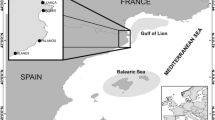Abstract
Seahorse populations throughout the world are vulnerable toexploitation for use in traditional Chinese medicines. Variouscaptive breeding ventures have been established in attempts tomeet the demand and to reduce the pressure on the naturalpopulations. Many of these programmes have relied on the captureof wild pregnant males which then give birth under captiveconditions. This would however limit production during the non-breeding season. In this study Knysna seahorses, Hippocampuscapensis, were bred in captivity during the non-breeding season(winter) using photothermal manipulation. Three constantphotoperiods (20L:4D, 16L:8D & 12L:12D) were tested incombination with three temperatures (22 °C, 25 °C& 28 °C). All combinations tested were successful inextending the breeding season of H. capensis. The frequency ofpregnancies as well as the number of young produced/pregnancy wasnot affected by the different photoperiod/temperaturecombinations. Each male gave birth to 39.38 ± 20.81juveniles every 34.03 ± 17.25 days during a four monthperiod. The mean juvenile weight and length was influenced by thephotoperiod and/or temperature regimes. Juvenile length decreasedwith increasing temperature (p ≤ 0.0001), while an increasein the light phase of the photoperiod regime at 20L:4D resultedin a significant increase (p ≤ 0.0006) in length whencompared to the 16L:8D and 12L:12D photoperiods. Juvenile weightdecreased with increasing temperature, while the combination ofphotoperiod 16L:8D and the lowest water temperature (22 °C)yielded the highest mean weights. Further studies are necessaryto determine whether mean juvenile weight or length influencesjuvenile survival
Similar content being viewed by others
REFERENCES
Arnold, C.R. (1988) Controlled year-round spawning of red drum Sciaenops ocellatus in captivity. In Arnold, C.R., Holt, G.J. and Thomas, P., eds, Contributions in marine science, Port Aransas, TX: Marine Science Institutes, pp. 65–70.
Bye, V.J. (1984) The role of environmental factors in the timing of reproductive cycles. In Potts, G.W and Wootton, R.J., eds, Fish Reproduction Strategies and Tactics, London, UK: Academic Press}, pp. 187–205.
Blythe, W.G., Helfrich, L.A. and Libey, G. (1994) Induced maturation of striped bass Morone saxatilis exposed to 6, 9, and 12 month photothermal regimes. Journal of the World Aquaculture Society 25, 183–192.
Connaughton, M.A. and Taylor, M.H. (1996) Effects of photoperiod and temperature on sexual recrudescence in the male weakfish, Cynoscion regalis. Environmental Biology of Fishes 45, 273–281.
Davies, P.R. and Hanyu, I. (1986) Effect of temperature and photoperiod on sexual maturation and spawning of the common carp I. Under conditions of high temperature. Aquaculture 51, 277–288.
De Vlaming, V.L. (1972) The effects of temperature and photoperiod on reproductive cycling in the estuarine gobiid fish. Fishery Bulletin 70, 1137–1151.
Duvenage, I.R. and Morant, P.D. (1984) Report No 31 Keurbooms/Bitou system (CMS 19), Piesang (CMS 18). Estuaries of the Cape Part II: synopses of available information on individual systems. Heydorn, A.E.F. and Grindley, J.R. eds, CSIR Research Report, 430, 1–64
Goombridge, B. (ed.) (1993) 1994 IUCN Red List of Threatened Animals. Gland andCambridge: IUCN.
Grange, N. and Cretchley, R. (1995) A preliminary investigation of the reproductive behaviour of the Knysna seahorse, Hippocampus capensis Boulenger. 1900. South African Journal of Aquatic Science 21, 103–104.
Grindley, J.R. (1985) Report No 30 Knysna Estuary. Estuaries of the Cape Part II. Synopses of available information on individual systems. Heydorn, A.E.F. and Grindley, J.R. eds}, CSIR Research Report, 429, 1–82.
Guraya, S.S., Saxena, P.K. and Gill, M. (1976) Effect of long photoperiod on the maturation of ovary of the catfish, Mystus tengara (Ham.). Acta Morphol. Neerl.-Scand. 14, 331–338.
Joubert, P. (1996) National Parks Board, Knysna, Personal Communication.
Kadmon, G., Yaron, Z. and Gordin, H. (1985) Sequence of gonadal events and oesstradiol levels in Sparus aurata (L.) under two photoperiod regimes. Journal of Fish Biology 26, 609–620.
Kaya, C.M. (1973) Effects of temperature and photoperiod on seasonal regression of gonads of green sunfish, Lepomis cyanellus. Copeia 2, 369–373.
Kok, H.M. (1981) Knysna Seahorse distribution poses a problem. African Wildlife 35, 9.
Lam, T.J. (1983) Environmental influences on gonadal activity in fish. In Hoar, W.S., Randall, D.J. and Donaldson, E.M., eds, Fish Physiology IX (Part B) New York: Academic Press, pp. 65–101.
Lee, C.S. and Hirano, R. (1985) Effects of water temperature and photoperiod on the spawning cycle of the sand borer, Sillago sihama. Progressive Fish Culturist 47, 225–230.
Peter, R.E. (1981) Gonadotropin secretion during reproductive cycles in teleosts: Influences of environmental factors. General Comparative Endocrinology 45, 294–305.
Shimizu, A. (1985) Effect of photoperiod and temperature on reproductive activity of themummichog Fundulus heteroclitus during various seasons. In Goetz, F.W. and Thomas,P., eds, Proceedings of the Fifth International Symposium on the Reproductive Physiologyof Fish, July, 1995 Austin, Texas: Fish Symposium Publishers pp. 197.
Skelton, P.H. (1987) South African Red Data Book-Fishes, South African National Scientific Programmes Report, 137, 93–95.
Vincent, A.C.J. (1994) Seahorses exhibit conventional sex roles in mating competition, despite male pregnancy. Behaviour 128, 135–151}.
Vincent, A.C.J. (1996) The international trade in seahorses. Oxford, UK: University of Oxford, pp. 159.
Whitfield, A.K., Allanson, B.R. and Heinecken, T.J.E. (1983) Report No 22: Swartvlei (CMS 11). Estuaries of the Cape Part II. Synopses of available information on individual systems. Heydorn, A.E.F. and Grindley, J.R., eds, CSIR Research Report, 421, 1–62.
Whitfield, A.K. (1995) Threatened fishes of the world: Hippocampus capensis Boulenger, 1900 (Syngnathidae). Environmental Biology of Fishes 44, 362.
Yoshioka, H. (1966) On the effects of environmental factors upon the reproduction of fishes. III. The occurrence and regulation of refractory period in the photoperiodic response of medaka, Oryzias latipes. J. Hokkaido Univ. Educ. 17, 23–33.
Zohar, Y. (1990) Fish reproduction: its physiology and artificial manipulation. In Shilo, M. and Sarig, eds, Fish culture in warm water systems: problems and trends, Boca Raton, FL: CRC Press Inc., pp. 65–119.
Author information
Authors and Affiliations
Rights and permissions
About this article
Cite this article
Lockyear , J., Kaiser , H. & Hecht , T. Studies on the captive breeding of the Knysna seahorse, Hippocampus capensis. Aquarium Sciences and Conservation 1, 129–136 (1997). https://doi.org/10.1023/A:1018395803722
Issue Date:
DOI: https://doi.org/10.1023/A:1018395803722




